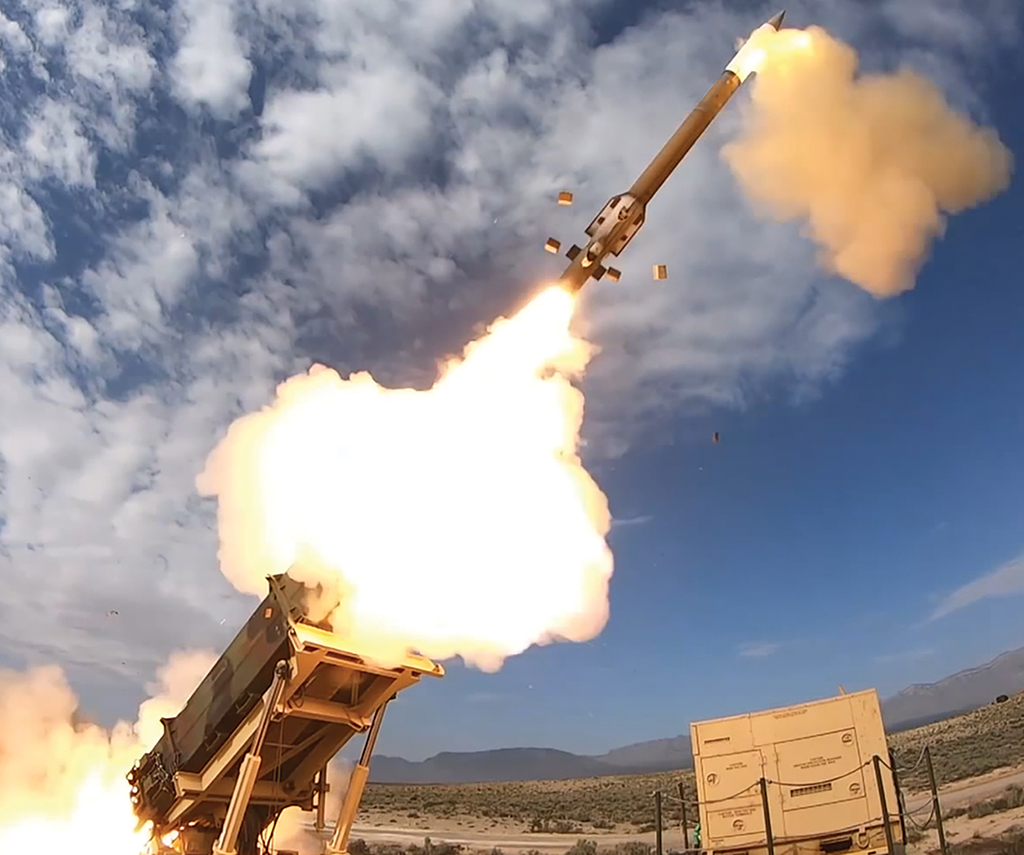
Cruise missile swarms, as depicted in this concept, and salvos of ballistic and hypersonic missiles are the new threats facing Guam.
On the decaying tarmac of Site Armadillo on the remote Northwest Field airstrip on Guam, a battery of the U.S. Army’s most advanced missile interceptors stands alone, the U.S. territory’s only protection from a ballistic missile attack.
But much has changed since the Army permanently deployed one of its seven Terminal High-Altitude Area Defense (THAAD) batteries to the Mariana Islands in 2015 in response to North Korean ballistic missile tests. Since then, that nation’s ballistic missile capabilities have expanded, yet Pyongyang now ranks as a second-tier threat to Guam, a key operational and logistics hub for the U.S. military in the Western Pacific.
- Sites have been selected for deployment of first layer in 2024
- Strategies to integrate system elements are still under review
The primary concern now is China. In the last eight years, the Chinese military has fielded a diverse range of new capabilities with the range to target Guam, including the DF-17 missile with a hypersonic glide vehicle (HGV), the DF-26 intermediate-range ballistic missile (IRBM) and the air-launched CJ-20 land-attack cruise missile (LACM). If launched in salvos of dozens from multiple directions, the Chinese arsenal could encircle and overwhelm a THAAD battery’s nonrotating TPY-2 radar and 48 interceptors.
A multibillion-dollar effort is underway to transform Guam—an island three times the size of the District of Columbia—into an impregnable bastion, invulnerable to missile attack. The Missile Defense Agency (MDA) has selected the sites this year for the first layer of defense, scheduled to become operational by the end of 2024. In the years to come, the MDA plans to add new defenses steadily until Guam is capable of repelling attacks from any direction by all types of missiles.
Moreover, the agency’s chosen architecture seeks to unify the U.S. military’s traditionally divided approach to land- and sea-based missile defense. The Guam Defense System is planned to integrate sensors, interceptors and command-and-control nodes developed separately over several decades for the Army, Navy and MDA itself. In the process, the integrated architecture may provide a new template for addressing a diverse array of new threats to the homeland, including HGVs launched from orbital rockets, stealthy cruise missiles and high-altitude balloons.
“You look at where Guam is situated, and it is a strategic location,” Vice Adm. Jon Hill, MDA director, said at an event hosted by the Center for Strategic and International Studies on March 24. “It’s a critical part of any skirmish that might happen in the Indo-Pacific.”
Future defenses must solve the limitations of the current architecture, which include capacity, coverage and flexibility. The THAAD battery at Site Armadillo offers an impressive counter against salvos of IRBMs in the terminal phase of a lofted ballistic trajectory from the northwest but little resistance to low-altitude threats, such as maneuvering HGVs and sea-skimming LACMs, coming in from all points of the compass.
In broad terms, the architecture for Guam’s planned defense is straightforward. A new, land-based variant of the Navy’s Aegis Combat System is to be assigned to shoot down IRBMs and HGVs, such as DF-26s and air-launched DF-21s. In the distant future, the MDA plans to add the Glide-Phase Interceptor (GPI) to counter HGVs more effectively, augmenting the existing Sea-Based Terminal defense, which relies on a special variant of the Raytheon SM-6 interceptor, against hypersonic weapons.
To intercept LACMs and long-range, loitering munitions, the MDA has chosen a mix of medium-range Patriot missile batteries and the Army’s short-range Indirect Fire Protection Capability (IFPC) Increment 2, which pairs Dynetics’ Enduring Shield launcher with a ground-launched version of Raytheon’s AIM-9X Sidewinder.
The MDA’s vision for Guam resembles the layered and diverse architecture deployed in Israel, a country five times larger and facing a similar 360-deg. threat of local and regional missile attacks.
The Israel Aerospace Industries/Boeing Arrow 3 and 4 interceptors form the front-line defense against IRBM salvos, and the Rafael/Raytheon David’s Sling system is equipped with Stunner interceptors positioned to bring down short-range ballistic missiles and LACMs. Finally, the Iron Dome system, which the U.S. Army deployed to Guam in 2021 as an experiment, defends Israel from attacks by rockets, mortars and loitering munitions.
Although seemingly straightforward, the MDA’s architecture for Guam introduces a number of integration challenges that could take several years to resolve fully.
The evolution of the ballistic missile defense solution for Guam illustrates the challenges. For several years, Adm. (ret.) Phil Davidson, who retired as commander of U.S. Indo-Pacific Command in 2021, advocated for installing the stationary, fixed-site Aegis Ashore system on Guam.

By the time the Biden administration committed to launching the Guam Defense System in the fiscal 2023 budget, however, the MDA had chosen a different approach. A string of 1,000-1,300-ft. mountain peaks along Guam’s southwest coast renders impossible 360-deg. coverage to the horizon from any single location. Instead, agency officials plan to distribute the four SPY-6 radar arrays of the Aegis Combat System around the island. The radars also are to be converted from stationary platforms to transportable vehicles, which requires changing the name of the system to the TPY-6.
The Aegis interceptors, including long-range SM-3s and short-range SM-6s, are reserved for IRBMs and HGVs, but the TPY-6s also would provide detection and tracking for LACMs. Since the latter are to be assigned to the Patriot and IFPC interceptors, some form of integration is necessary between the Navy’s radars and Army’s batteries.
Integration of a set of distributed sensors and different types of launchers is nothing new in the missile defense sector. Two decades ago, the Navy’s Cooperative Engagement Capability (CEC) program networked surface and airborne sensors to create an integrated fire control system to repel attacks by fighters and cruise missiles. More recently, the Army’s Integrated Air and Missile Defense Battle Command System allowed a THAAD battery’s X-band radar to hand off a track to the Patriot battery’s C-band fire control system.
For the Guam Defense System, the MDA must decide how to hand off long-range target tracks in the near term from the S-band TPY-6 radar of the Aegis system to the C-band MPQ-53 fire control radar of a Patriot battery. As additional layers of the architecture come online, similar integration challenges await the arrival of GPIs cued from space-based sensors, such as the MDA’s proposed Hypersonic and Ballistic Tracking Space Sensor, the Space Development Agency’s Tracking Layer and Space Systems Command’s Missile Track Custody program.
The MDA has demonstrated the ability to hand off cruise missile tracking data from the CEC to a Patriot battery. A July 2021 test of the Joint Track Management Capability (JTMC) Bridge allowed a Patriot battery to shoot down a surrogate missile, even as the MPQ-53 radar was being jammed.
Fusing track-level information enables a launch-on-remote capability, meaning a physically separated sensor can cue the launch of a remote missile battery.
Eventually, however, the MDA aims to achieve an “engage-on-remote” capability, which would allow remote sensors to feed updated tracking coordinates continuously to an interceptor after launch. Such continuous updates are not required to intercept the predictable path of a ballistic missile but may be necessary to shoot down a maneuvering HGV or LACM.
“I will tell you that’s hard,” Hill said. “What you’ve got is maybe a track that’s coming through Aegis that you’re not seeing in ICBS. And you have to somehow associate that with the track in your [ICBS] track stores. You can end up with duplicates and those sorts of things.”
The July 2021 demonstration of the JTMC Bridge was important, but it stopped short of a proving a combat-ready capability.
“There’s a lot of work to get done to [reach the point] where we can feel confident that we’re not going to screw up the track picture,” Hill said.
For Guam, the MDA’s options are to fuse the tracking information at one of three levels: directly between Aegis and ICBMS, indirectly through the JTMC Bridge capability or indirectly through the MDA’s existing Command-and-Control, Battle Management and Communications (C2BMC) system, which was designed to support ballistic missile tracking.
“So what’s the best way to do it? C2BMC, direct tap to the radar or through the Bridge?” Hill asked rhetorically. “We’re running lots of studies on that right now to see which is the best.”
In the near term, internal spending pressures may drive the MDA to use the C2BMC.
“We can do what we know how to do right now just to meet the [2024 fielding schedule] and then continuously improve,” Hill said. “So we’ll get there, but it won’t be in the first instantiation because it’s just very hard engineering work.”

Comments